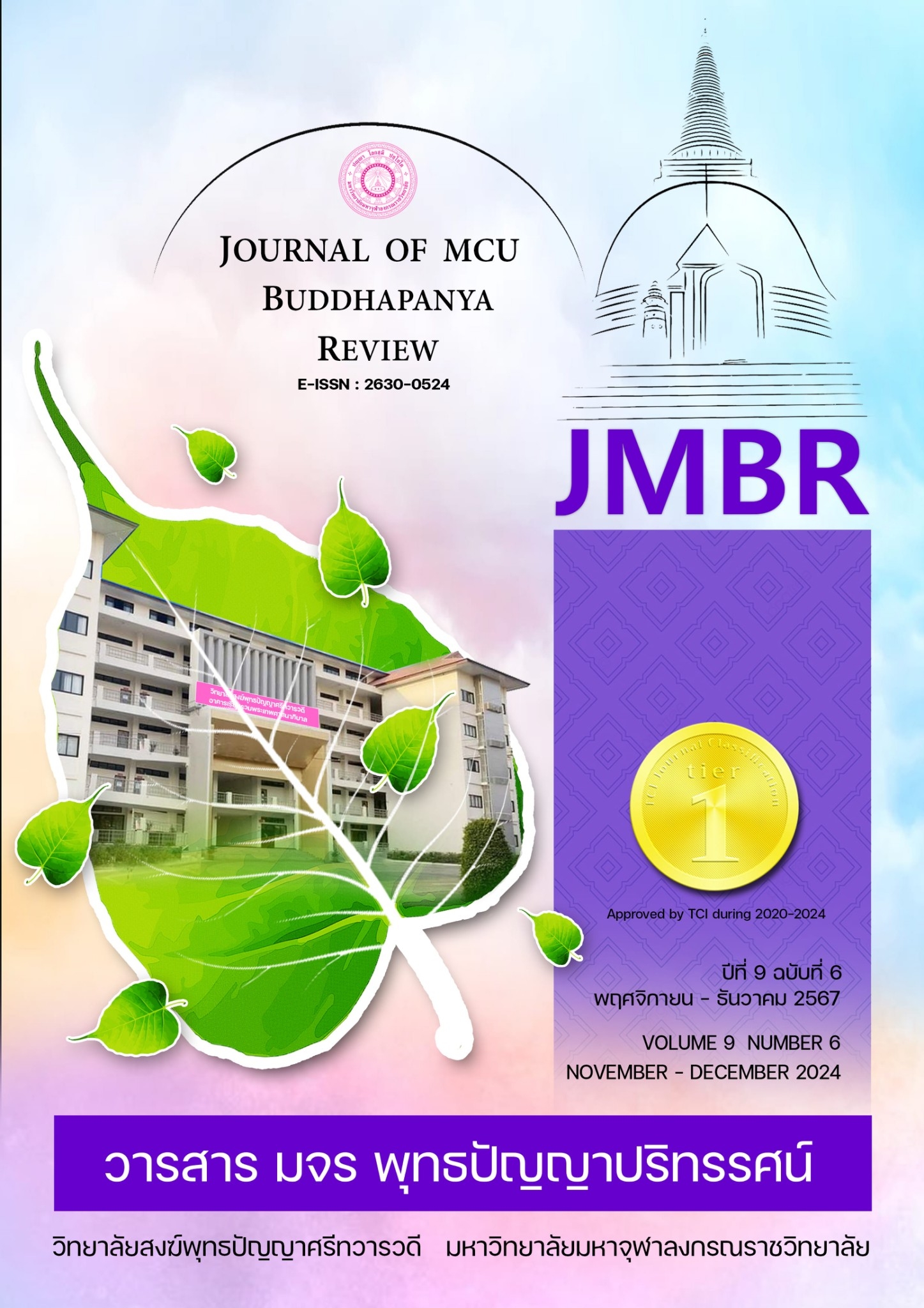การพัฒนาคุณภาพผลิตภัณฑ์ที่เกิดจากภูมิปัญญาชาวบ้านเพื่อสร้างมาตรฐานกระถางต้นไม้ ปูนปั้นจากปูนซีเมนต์ผสมโฟมของกลุ่มผู้ประกอบการใน ตำบลม่วงหมู่ อำเภอเมืองสิงห์บุรี จังหวัดสิงห์บุรี
คำสำคัญ:
ภูมิปัญญา, คอนกรีตมวลเบา, ขยะโฟม, กระถางต้นไม้ปูนปั้นบทคัดย่อ
บทความนี้ มีวัตถุประสงค์เพื่อศึกษา 1) กระบวนการผลิต คุณลักษณะ คุณภาพ และอัตราส่วนที่เหมาะสมเป็นมาตรฐานในการนำโฟมมาเป็นส่วนผสมของการผลิตกระถางต้นไม้ปูนปั้นของกลุ่มผู้ประกอบการใน ตำบลม่วงหมู่ อำเภอเมืองสิงห์บุรี จังหวัดสิงห์บุรี และ 2) กระบวนการถ่ายทอดองค์ความรู้สู่การปฏิบัติจริงการผลิตกระถางต้นไม้ปูนปั้น ด้วยวิธีการทดสอบหาค่าแรงอัดและความหนาแน่นแห้งของก้อนซีเมนต์มอร์ตาร์ขนาด 50 x 50 x 50 มิลลิเมตร ที่อายุ 28 วัน ตามมาตรฐานสมาคมวิชาชีพทางด้านวิทยาศาสตร์และเทคโนโลยี จากนั้นใช้ทฤษฎีก้างปลา และวิธีการเชิงระบบ โดยการสนทนากลุ่มกับกลุ่มเป้าหมาย 10 ราย วิเคราะห์และสรุปข้อมูล โดยการวิเคราะห์เนื้อหา เพื่อนำเสนอกระบวนการถ่ายทอดองค์ความรู้สู่การปฏิบัติจริง
ผลการศึกษา พบว่า อัตราส่วนที่เหมาะสมเป็นมาตรฐาน คือ ซีเมนต์ : ทราย : น้ำ เท่ากับ 1.0 : 1.0 : 0.4 และเม็ดโฟมร้อยละ 37 โดยปริมาตร ซึ่งมีหน่วยน้ำหนักประมาณ 1,300 กิโลกรัมต่อลูกบาศก์เมตร และมีค่ากำลังรับแรงอัด เท่ากับ 4.5 เมกะปาสคาล และรูปแบบของกระบวนการถ่ายทอดองค์ความรู้สู่การปฏิบัติจริง ประกอบด้วย 5 องค์ประกอบ ได้แก่ 1) ปัจจัยนำเข้า คือ อัตราส่วนที่เหมาะสมเป็นมาตรฐาน 2) กระบวนการ เป็นการสร้างความสนใจคุณค่าของผลการศึกษา การสอดแทรกความรู้ และการปั้นกระถางต้นไม้ด้วยอัตราส่วนที่เหมาะสมเป็นมาตรฐาน 3) ผลผลิต กระถางต้นไม้ปูนปั้นที่เป็นมาตรฐานและต่อปั้นของช่างปั้นที่มีความแตกต่างกัน 4) การควบคุม คือ ด้านคุณภาพของกระถางต้นไม้ปูนปั้นที่ต้องมีอัตราส่วนที่เหมาะสมเป็นมาตรฐาน และ 5) ข้อมูลย้อนกลับ คือ ความคิดเห็นที่จะเป็นข้อมูลในการแก้ไขปรุบปรุงให้กระบวนการถ่ายทอดองค์ความรู้มีความชัดเจนถูกต้อง นำไปต่อยอดพัฒนาการผลิตสินค้า หรือผลิตภัณฑ์ชนิดใหม่ในอนาคตเพื่อสร้างความยั่งยืนให้กับชุมชนต่อไป
References
American Society for Testing and Materials. (2020). Standard Method of Test for Compressive Strength of Cylindrical Concrete Specimens. ASTM C39 / C39M-20. Annual Book of ASTM Standards.
Castaneda, D. I., Manrique, L. F., & Cuellar, S. (2023). The knowledge management conceptual system: An integrative and dynamic vision. Journal of Knowledge Management, 27(7), 2094-2114.
Chen, X., & Li, S. (2023). Digital transformation in knowledge management: A systematic literature review. International Journal of Information Management, 70, 102809.
Chanpeng, T., et al. (2023). A study of the economic value of producing lightweight concrete mixed with recycled foam pellets in a small-scale industry. Rajamangala University of Technology Thanyaburi Journal of Engineering, 21(1), 157-170.
Kanchanawasi, S., et al. (2022). Educational Evaluation: Concepts to Practice. Bangkok: Chulalongkorn University Press.
Kulsuwan, N., et al. (2022). Effect of recycled foam bead size on properties of lightweight concrete. KMUTT Research and Development Journal, 45(4), 501-515.
Maneerat,W., et al. (2023). Development of lightweight concrete mixed with recycled foam beads for environmentally friendly construction. Thai Environmental Engineering Journal, 37(2), 89-102.
National Research Office. (2023). Science, Research and Innovation Plan 2023-2027. Bangkok: National Research Office.
Office of Natural Resources and Environmental Policy and Planning. (2022). Environmental Quality Situation Report 2021. Bangkok: Ministry of Natural Resources and Environment.
Office of Small and Medium Enterprises Promotion. (2024). Cement mortar formwork CEMENT CUBE MOLD size 5 x 5 x 5 cm. Retrieved March 10, 2024, from https://thaismegp.com/ product/ 62f0c6ccc4ef377c71b96cd8#error=login_required &state=2927ce1c-7f10-4b7a-89cd-c831c7f8d90e.
Pollution Control Department. (2023). Thailand Pollution Situation Report 2022. Bangkok: Ministry of Natural Resources and Environment.
Rattanasuwan, T. and Chomchaisunthon, w. (2022). Green Concrete: Innovation for Sustainability in Construction. Thai Environmental Engineering Journal, 36(1), 15-28.
Sitticharoen, W., et al. (2023). Modern Concrete Technology. Bangkok: Chulalongkorn University Press.
Tamuangmoon, T. and Sriphan, A. (2023). Model Learning of Wisdom Entrepreneur Ceramic in Lampang Province. Journal of MCU Buddhapanya Review, 9(1), 254-264.
Theunkaewsing, S., et al. (2023). Improving the mechanical properties of lightweight concrete mixed with foam beads using superplasticizers. Thai Environmental Engineering Journal Chiang Mai University, 30(1), 71-85.
United Nations. (2023). The Sustainable Development Goals Report 2023. Retrieved March 9, 2024, from https://unstats.un.org/sdgs/report/2023/
Wattanasuwan, S., et al. (2023). Application of quality tools in manufacturing process development. Chiang Mai University Journal of Engineering, 30(2), 221-235.
Downloads
เผยแพร่แล้ว
How to Cite
ฉบับ
บท
License
Copyright (c) 2024 วารสาร มจร พุทธปัญญาปริทรรศน์

This work is licensed under a Creative Commons Attribution-NonCommercial-NoDerivatives 4.0 International License.


